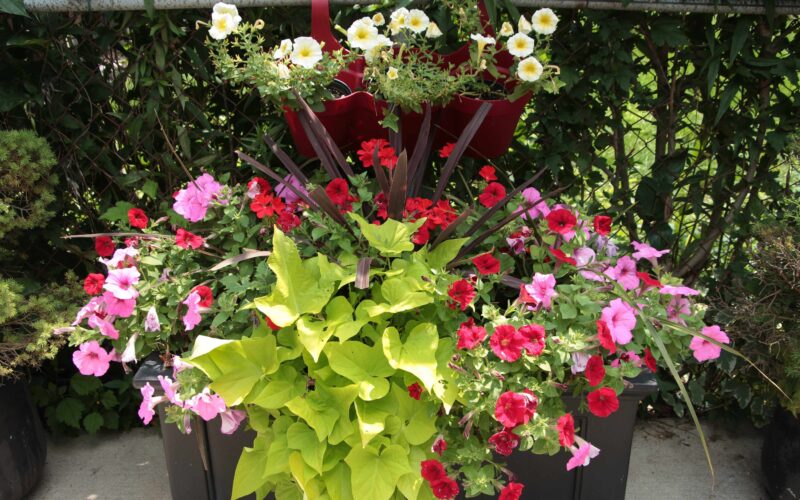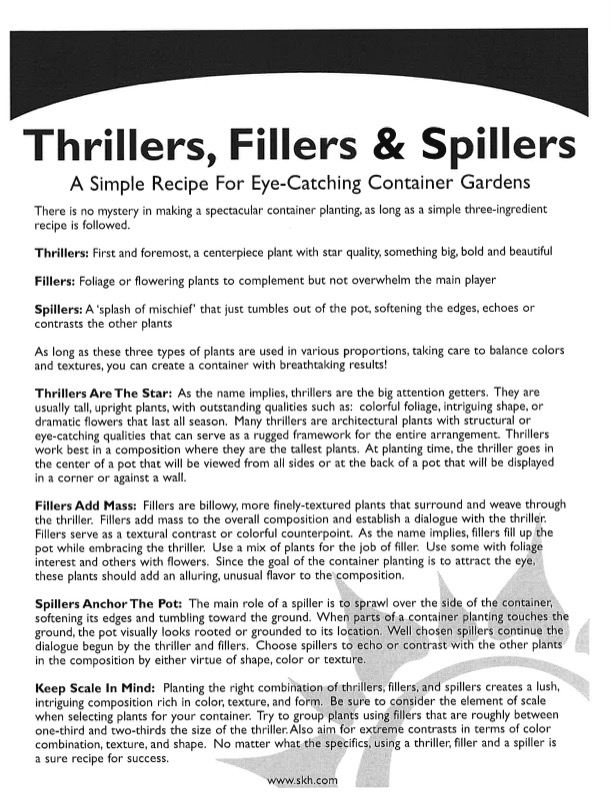Plant to Impress: Container Garden Ideas

Container gardens are more than just plants in pots—they are a way to create your very own garden oasis. From vibrant flowers sprouting from antique urns to hanging vines tumbling from a modern planter, the possibilities are practically endless! With our container garden ideas, you’ll be ready to design one that’s both functional and visually stunning.
What Is A Container Garden?
A container garden is when you plant in containers rather than in the ground. This is especially popular in urban areas where having a physical garden isn’t realistic. And you’re not just limited to houseplants! You can grow vegetables, fruits, flowers, and herbs in a variety of planters all around your home.
Container gardening has several perks. Planters take up less space than a traditional garden and are easier to move and arrange however you want. Along with flexibility, they make stunning decorations. And for those on a budget, they can be a cheap option by allowing you to reuse old containers from around your house.
The Best Container Garden Plants
Now that we’ve covered what a container garden is, we’re ready to get to the plants! Container garden design isn’t random—there’s a science to it, and we’re here to teach you the basics. To make your arrangement eye-catching and balanced, you need to understand the concept of thriller, filler, and spiller plants.
Thrillers
Thrillers are the star of the show. They are the centerpiece of your container garden—something big, bold, and beautiful. Usually with colorful flowers or dramatic foliage, they serve as a framework for the entire arrangement.
Thrillers should be the tallest plant, and if you have a lightweight container, avoid topheaviness by using rocks in the bottom to weigh it down. Choose a thriller that is about 1.5 times the height of your container, and plant it in the center or back of your pot.
Our favorite thrillers:
Sun
- Angelonia
- Geraniums
- Grasses
- Papyrus
- Umbrella plant
Shade
- Caladium
- Coleus
- Dracaena
- Fuchsia
- Impatients
Fillers
Fillers are plants that complement your centerpiece, but don’t overwhelm it. They are more finely textured and billowy, adding mass to the overall composition. Fillers should work together with the thriller to create interest and add pops of color by weaving throughout.
We recommend using a mix of plants for this—some with foliage and others with flowers. That adds textural contrast and a colorful counterpoint.
Our favorite fillers:
Sun
- Copperleaf
- Eucalyptus
- Gerbera daisy
- Petunia
- Salvia
Shade
- Boston fern
- Heliotrope
- Nemesia
- Rex Begonias
- Torenia
Spillers
Spillers just add a little something special. You often see them tumbling out of the planter and touching the ground, helping the arrangement look visually rooted. This softens the edges of your container and anchors the pot. Choose spillers that either complement or contrast with the rest of your plants in shape, color, or texture.
Our favorite spillers:
Sun
- Asparagus fern
- Ivy geranium
- Lotus
- Purple heart
- Verbena
Shade
- Creeping wire vine
- Dragonwing begonia
- Lamium beacon silver
- Lobelia
- Vinca vine
The best container garden plants include at least one of each of these categories. This three-part “recipe” makes it easy to create beautiful arrangements and hopefully gets your gears turning with more container garden ideas!
Download this PDF to dive deeper into thriller, filler, and spiller plants:

Tips For Arranging Your Plants
Now that you have your thriller, filler, and spiller plants, it’s time to arrange them. Always keep scale in mind. You need to find the right balance of the three to create a lush, interesting composition that’s rich in color, texture, and form.
We recommend grouping plants using fillers that are about ⅓ to ⅔ the size of the thriller. Aim for extreme contrasts to create a more eye-catching container garden design.
Choosing The Best Material for Your Container Garden
Now let’s dive into the “container” part of container gardening. When you’re looking for container garden ideas, the first step is choosing your planter. There are plenty of styles and materials to pick from.
1. Clay or Terracotta
Clay planters are a heavy option that can break easily if you’re not careful. They crack in cold temperatures and absorb heat in the warm months. On the plus side, clay is porous, which allows for good airflow so the roots of your plants can breathe.
Unglazed containers dry out quickly and require more watering, so they perform better in the shade. Glazed pots, however, can be placed right in the sun.
2. Plastic
Plastic container gardens are a lightweight option that come in a wide variety of styles to match your unique taste. They are a cheaper choice, while still being extremely durable and frost-proof. Unlike clay, plastic is non-porous, so your plants won’t have to be watered as much!
3. Metal
Stylish and durable, metal garden containers are a popular choice. You can use old buckets, pots, and cans to create these on your own. But be careful—metal can get extremely hot in the sun, so consider inserting a plastic liner to help insulate your plant’s roots.
4. Wood
Solid wood planters are great for water retention and are relatively lightweight. Other containers, like wooden crates or baskets, may require a liner. Keep in mind that wood can rot over time, so it may need more maintenance than other materials.
5. Ceramic
Go the colorful route with ceramic pottery! These glazed garden containers come in a variety of colors and styles, and are less likely to be impacted by temperature changes. However, they are heavy, breakable, and more expensive.
6. Concrete or Stone
Concrete and stone containers are a classic material that can withstand any weather. This means they will last for years! They provide good insulation for your plants, but they are heavy and hard to move around, so plan ahead.
7. Fiberglass or Resin
This synthetic option often looks like stone, but isn’t as heavy. They are durable and frost-proof, but also easy to move. Since it can fade over time, consider choosing one with UV protection.
Ultimately, the best material for container gardens is up to you! Explore our diverse selection of planters and pottery to get started.
Quick Tips for Your Garden Containers
- Remember, all containers and liners should have a drainage hole to avoid root rot.
- If you’re using a recycled container, disinfect it with a water-vinegar solution (three parts water, one part vinegar).
- Be mindful of size. Always choose planters that are about two inches larger in diameter than your plant’s root system.
- Place your container where you want it before filling it with soil. This keeps your heavy lifting to a minimum.
Creative Container Garden Ideas
What makes container gardening so unique is the variety of planters! Add a splash of personality to your arrangement by using (or reusing) containers like:
- Old buckets
- Tubs
- Wicker baskets
- Pots
- Colanders
- Old crates
- Barrels
- Bike baskets
- Wagons
- Old drawers
When the air turns crisp, you can also get seasonal and build a fall-themed container garden. Carefully curate your plants and containers to create the perfect autumn vibe.
Container Garden Soil
The base of any successful container garden is a quality potting mix. Our new collection of premium soils has everything you need to make your plants thrive, including slow-release fertilizer that feeds up to nine months. It’s our go-to for all our container garden soil needs!
Where To Put Your Container Garden
Location is super important, and thankfully, the options are virtually endless. Whether you’re looking indoors or outdoors, container gardens elevate any space. Put them by a window, on your porch or patio, in a raised container, on plant stands, or even in hanging baskets!
The most important consideration should be the light needs of your plants so you can make sure they get enough sun or shade to thrive. And of course, show off your hard work by putting them somewhere visible so you can enjoy your container garden every single day.
With these tips and ideas fresh in your mind, you’re ready to begin planning! Check out our plant and container options to begin building your own container garden.

